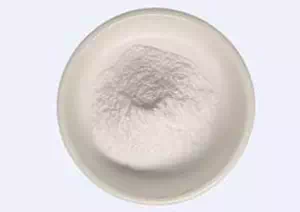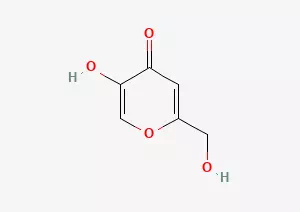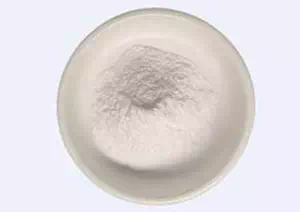All Categories



kojic acid CAS 501-30-4, kojic acid CAS 501-30-4
Kojic acid, as an organic acid with unique antibacterial effects, has a distinctive production process. It is produced by the aerobic fermentation of glucose by Aspergillus candida at a specific temperature of 30-32 ℃.
CAS : 501-30-4
Formula : C6H6O4
Mol. wt. : 142.11
EINECS : 207-922-4
Chemical Name | Kojic acid |
Other Name | 4H-Pyran-4-one, 5-hydroxy-2-(hydroxymethyl)-; 5-Hydroxy-2-(hydroxymethyl)-γ-pyrone |
CAS | 501-30-4 |
EINECS | 207-922-4 |
Type | Food additives; Pharmaceutical raw materials; Organic raw materials; Cosmetic raw materials; Plant extracts |
Molecular Formula | C6H6O4 |
Molecular Weight | 142.11 |
Melting point | 152-155 °C (lit.) |
Boiling point | 179.65°C (rough estimate) |
density | 1.1712 (rough estimate) |
refractive index | 1.4434 (estimate) |
storage temp. | Store below +30°C. |
solubility | DMSO (Slightly), Methanol (Slightly, Sonicated) |
pka | 7.9(at 25℃) |
form | Crystalline Powder |
color | White to beige-brown |
Water Solubility | SOLUBLE |
Kojic acid, as an organic acid with unique antibacterial effects, has a distinctive production process. It is produced by the aerobic fermentation of glucose by Aspergillus candida at a specific temperature of 30-32 ℃. During this fermentation process, Aspergillus candida plays a crucial role. It utilizes its unique metabolic mechanism to interact with glucose in an aerobic environment. Through a series of complex biochemical reactions, it eventually produces kojic acid, a special substance.
From the perspective of molecular structure, kojic acid presents a structural form of γ -pyrrolidone with substituents. Among the numerous γ -pyrrolidone compounds that are widely present in nature, only kojic acid and maltitol are truly well-known and famous to people.
Looking back at the research history of kojic acid, in 1907, Saito successfully isolated kojic acid crystals from rice kojic through rigorous scientific experiments. This discovery laid the foundation for the subsequent in-depth research on kojic acid. In 1912, Yabuta named it, giving this substance a clear identity in the field of science. Subsequently, in 1924, through further research, scientists finally determined the molecular structure of kojic acid, which further deepened people's understanding of kojic acid.
In 1953, Arnstela (using the surface fermentation method) and Kitada Makuo (using the deep fermentation method) in 1971, by utilizing advanced isotope tracking technology and through repeated experiments and demonstrations, successfully proved that kojic acid was directly oxidized and dehydrated from glucose. And it was formed without the carbon frame breaking during this process. This significant research achievement has revealed the biosynthetic pathway of kojic acid, providing a theoretical basis for its industrial production and application.
Kojic acid also has certain forms of existence in daily life. It exists in kojic acid, which is something that people often consume and safely use in their long-term life practice. In recent years, with the continuous development of science and technology and people's pursuit of beauty, a large number of patent documents have begun to report the application of kojic acid in the field of cosmetics.
In the physiological processes of the skin, tyrosinase plays a crucial role and is a key enzyme for the production of melanin. The reason why kojic acid has a whitening effect is that it can chelate copper in tyrosinase, thereby rendering tyrosinase inactive. This mechanism of action enables kojic acid to demonstrate unique advantages in whitening.
Clinical and application test results fully demonstrate that kojic acid has a strong inhibitory effect on the production of melanin in human skin. More importantly, while it exerts its whitening effect, it is safe and non-toxic, and will not cause the aftereffects of white spots like some other whitening ingredients, making people feel more at ease during the usage process.
In addition, when kojic acid is used in combination with other preparations, it can achieve better effects. For instance, when used in combination with SOD (superoxide dismutase), placenta extract, amino acids, sunscreen, and various plant extracts, these different ingredients work in synergy to improve skin conditions in multiple aspects and provide more comprehensive skin care.
For this reason, kojic acid has been widely used in the cosmetics industry, mainly in skin whitening products, anti-aging products, sun protection products, whitening facial cleansers and various beauty cosmetics, safeguarding people's beauty and skin health.
In addition to its application in the cosmetics field, kojic acid also has certain antibacterial activity. In terms of antibacterial properties, Gram-negative bacteria are more sensitive to sodium kojate than Gram-positive bacteria, which is exactly the opposite of the characteristics of most other antibacterial substances. However, it should be noted that the antibacterial effect of kojic acid is much lower compared to other antibacterial substances, and its antibacterial activity is mainly manifested as antibacterial rather than bactericidal. Meanwhile, kojic acid has no obvious inhibitory effect on yeast, viruses and bacteriophages.
In today's industrial field, kojic acid, with its unique chemical properties and diverse functions, has demonstrated extremely important application value in multiple industries, especially in key areas such as cosmetics, food processing, medicine, and agricultural pesticides.
It is used in industry to make cosmetics
The application of kojic acid in the cosmetics industry mainly stems from its powerful inhibitory effect on the synthesis of tyrosinase. Tyrosinase plays a crucial role in the formation of skin melanin, and kojic acid can precisely intervene in this key link, thereby strongly inhibiting the generation of skin melanin. It is worth mentioning that kojic acid, while exerting this remarkable effect, also possesses the excellent property of being safe and non-toxic. This undoubtedly serves as an important foundation for its wide application in the cosmetics field. Unlike some other ingredients that may cause side effects, kojic acid does not produce disturbing aftereffects such as white spots during use, which makes it an ideal raw material in the eyes of many cosmetic developers.
Based on these advantages of kojic acid, professionals in the cosmetics industry ingeniously formulate it into various forms of skin care products. For example, kojic acid is carefully integrated into the lotion to enable it to be evenly dispersed in the lotion system, providing long-lasting and stable whitening care for the skin. When made into a facial mask, kojic acid can act on the skin surface at a high concentration in a short time, penetrate deep into the skin layer, effectively inhibit the formation of melanin, and make the skin glow with a fair luster in a short period of time. Similarly, adding kojic acid to skin care cream not only enhances the whitening effect of the skin care cream but also, with its excellent moisturizing performance, enables kojic acid to be better absorbed by the skin and achieve its best whitening effect.
Thanks to the outstanding efficacy of kojic acid, these cosmetics with kojic acid added perform well in treating various skin pigmentation problems. Whether it's freckles caused by genetic factors, age spots that appear with age, pigmentation triggered by external environmental stimuli, or uneven skin pigmentation due to common acne problems, these high-end whitening cosmetics can all play an effective therapeutic role, helping users restore the fairness and smoothness of their skin. Show a healthy and confident skin condition.
After extensive scientific research and experimental verification, kojic acid at a concentration of 20ug/ml has demonstrated remarkable effects in inhibiting various tyrosinases (or polyphenol oxidase PPO), capable of suppressing their activity by 70-80%. This precise data provides an important reference basis for cosmetic R&D personnel, enabling them to control the addition amount of kojic acid in cosmetics more scientifically. Generally speaking, the addition amount of kojic acid in cosmetics is usually controlled between 0.5% and 2.0%. This addition range can not only ensure that kojic acid effectively exerts its whitening effect, but also guarantee the safety and stability of cosmetics, avoiding potential risks that may be brought about by excessive addition.
Used in food processing
In the field of food processing, kojic acid also plays an indispensable and significant role. As a high-quality food additive, kojic acid has multiple functions such as preservation, anti-corrosion and anti-oxidation, providing strong support for food storage and quality assurance.
A large number of scientific experiments have shown that kojic acid has a significant effect on food preservation. For instance, during the processing and storage of salted meat, sodium nitrite can transform into carcinogenic nitrosamines under certain conditions, which poses a potential threat to consumers' health. The addition of kojic acid can effectively inhibit this transformation process, significantly reducing the content of nitrosamines in salted meat, thereby enhancing the safety of salted meat and allowing consumers to consume it with greater peace of mind.
Not only that, the application of kojic acid in food also has a prominent advantage, that is, it does not affect the taste, aroma and texture of food. This characteristic makes kojic acid stand out among food additives, as many other food additives may change the original flavor and texture of food to a certain extent, while kojic acid can play its role in preservation, anti-corrosion and anti-oxidation without affecting the quality of food.
In addition to being directly used as a food additive for food preservation and anti-corrosion, kojic acid is also an important raw material for the production of maltol and ethyl maltol. In the relevant production processes, kojic acid, after a series of chemical reactions and fine processing, can be transformed into products such as maltol and ethyl maltol, which have significant economic value and broad application prospects. These products have a wide range of uses in the food industry, such as as spices and flavorings, adding rich flavors and textures to food.
It can be seen from this that kojic acid is widely used in the field of food processing. It not only provides a guarantee for the safety and quality of food, but also makes significant contributions to the development of the food industry by participating in the production of other products.
Medicinal use
In the field of medicine, the unique value of kojic acid has also been fully recognized and applied. Because kojic acid has no mutagenic effect on eukaryotic cells, this characteristic makes it highly safe in human applications. On this basis, kojic acid also has the ability to eliminate free radicals in the human body. Free radicals are harmful substances produced during the body's metabolic process, which can cause damage to human cells and trigger various diseases. Kojic acid can effectively eliminate these free radicals, protect human cells from their damage, and thereby enhance the strength of white blood cells. White blood cells, as an important component of the human immune system, the enhancement of their functions helps improve the body's immunity and has a positive impact on human health.
Due to these medicinal properties of kojic acid, it has been widely used in the production process of cephalosporin antibiotics as an important raw material. In the synthetic route of cephalosporin antibiotics, kojic acid plays a crucial role. It can participate in chemical reactions, influencing the structure and performance of antibiotics, thereby enhancing the efficacy and safety of antibiotics.
By applying kojic acid to the production of cephalosporin antibiotics, the finished drugs produced have shown ideal effects in the treatment of various diseases. For example, in the treatment of headache, this medicine can quickly relieve the symptoms of headache and reduce the pain of patients. For patients with toothache, it can effectively suppress the inflammatory response and alleviate the discomfort caused by toothache. When treating local inflammation, this drug has a good anti-inflammatory effect, which can promote the regression of inflammation and accelerate the healing of the affected area. In conclusion, the application of kojic acid in the medical field has made significant contributions to the cause of human health.
Agricultural pesticides
In the field of agriculture, kojic acid has also demonstrated great application potential. Kojic acid can be used in the production of biopesticides, providing a green and environmentally friendly solution for the prevention and control of crop diseases and pests.
Specifically, by adding 0.5-1.0% kojic acid to a particular formula, bio-microfertilizer can be produced. This bio-micro-fertilizer takes on the form of a deep red liquid and possesses unique physical and chemical properties. In practical applications, it can be applied to crops in various ways. On the one hand, when sprayed as a low-concentration foliar fertilizer, bio-micro-fertilizer can evenly adhere to the leaf surface of crops and be absorbed through the stomata and epidermal cells of the leaves, thereby exerting its role in promoting growth and increasing yield within the crops. On the other hand, when bio-micro-fertilizers are made into growth enhancers and applied to the roots, they can penetrate deep into the soil and be absorbed by the root systems of crops, providing comprehensive nutritional support for the growth of crops.
After a large number of field experiments and practical verifications, this bio-micro-fertilizer with kojic acid added has a significant yield-increasing effect on crops such as grains and vegetables. It can not only promote the growth and development of crops, enhance their stress resistance, but also improve the quality of crops, making agricultural products more superior and safe. Therefore, the application of kojic acid in the field of agricultural pesticides has brought new opportunities and hope to agricultural production, which is conducive to promoting the sustainable development of agriculture.
* Prompt reply and 24 hours online, professional team to provide best price and high quality product.
* Sample testing support.
* Every batch of products will be tested to ensureits quality.
*The packing also can be according the customers` requirment.
*Any inquiries will be replied within 24 hours.
*we provide Commerical Invoice, Packing List, Bill of loading, COA , Health certificate and Origin certificate. If your markets have any special requirements, let us know.